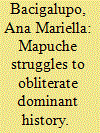| Srl | Item |
| 1 |
ID:
117888


|
|
|
|
|
| Publication |
2013.
|
| Summary/Abstract |
The biographical mythohistory of Rosa Kurin, an ethnically mixed Mapuche-German shaman in southern Chile in the late 1800s, expresses a 'shamanic historical consciousness' that advances current debates over the dynamic relationship between history and myth and between indigenous and national history. Biographical mythohistory is a mixed genre that mediates among different memoralisations of the past to obliterate dominant Chilean history and to create alternative indigenous histories. Mapuche shamanic mythohistories are simultaneously linear and cyclical: historical personages are transformed into mythical characters and sometimes back again, and mythical happenings manifest themselves repeatedly in historical events. Mapuche people create mythohistories by mythologising such shamans and historical outsiders, prioritising spiritual agency over political agency and narratively reversing the usual colonial dynamics of subordination. Mythohistories are, for rural Mapuche, a means of conveying agency, ethnic identity and ontology. They also offer a way to decolonise Mapuche history and have the potential for political mobilisation.
|
|
|
|
|
|
|
|
|
|
|
|
|
|
|
|
| 2 |
ID:
119507


|
|
|
|
|
| Publication |
2013.
|
| Summary/Abstract |
This article discusses spiritual healing in post-Soviet Kazakhstan with reference to changing discourses about 'shamanic illness': a condition that afflicts the future healer. What had traditionally been identified as the call of spirits was seized in the Soviet period by biomedical discourse which ascribed those symptoms to mental illness. Whereas this attitude also influenced popular understandings of 'shamanic illness' at the time, traditional ideas have been gradually restored in the context of the political and social changes of the 1990s. Biomedical discourse on 'shamanic illness' has also undergone significant changes. I argue that this was induced by multiple interconnected factors, among which are the reappraisal and support of the government for Kazakh 'folk' medicine as a part of the national heritage, and a favourable attitude to local, traditional forms of religiosity. This allowed for collaboration between doctors and healers in the context of institutionalization of traditional medicine. Alongside these influences the strength of the tradition of remembering the spirits of ancestors prompted the re-establishment of this core experience in the process of becoming a healer: the call of spirits.
|
|
|
|
|
|
|
|
|
|
|
|
|
|
|
|
| 3 |
ID:
096044


|
|
|
|
|
| Publication |
2010.
|
| Summary/Abstract |
This article is an attempt to understand 'locality', where the issues of subversion, subordination and marginalization as well as the problematic notions of liminality and empowerment are more vibrant and real. We shall demonstrate that while the low castes and untouchables were engaged in economic conflict, at various levels, with the high-caste landowners, which resulted in occasional uprisings too, the popular belief system was used by the marginalized as an instrument of assertion of their power against social coercion. It is argued that the social and ritual protest aimed at diluting or subverting the local caste hierarchy in a stratified society is an efficacious threat to the power of the high castes; that the hope of social revision becomes an alternative to economic subordination. More important, the symbols of empowerment are not the ones controlled by the high castes, but those which are located in the specialized rituals of the marginalized dalits. This article is about these symbols, which are liminal in nature, and how they empower, if only for a brief while, the economically exploited and socially marginalized dalit practitioners.
|
|
|
|
|
|
|
|
|
|
|
|
|
|
|
|